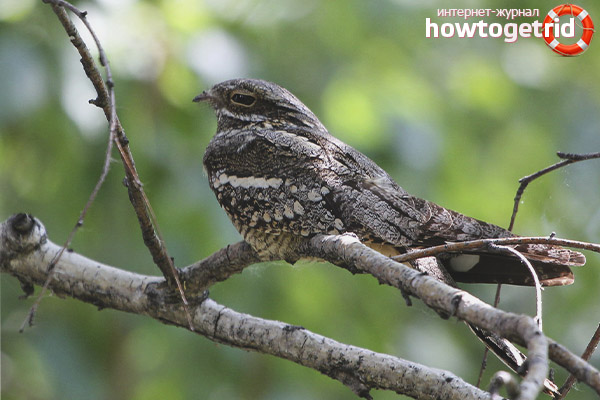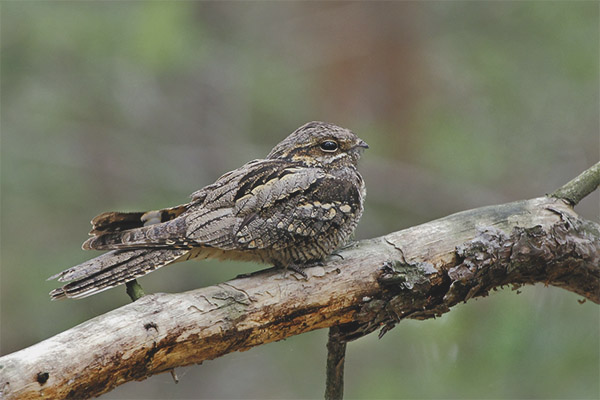The content of the article
Nightjar - this interesting name belongs to the birds of the numerous genus. These birds are remarkable in that they are exclusively nocturnal, and feed only on insects. Kozodoi live in the forests, this area is best suited for them, because they love to disguise. To see such birds in the forest is almost impossible, as they are well hidden, but you can hear their singing. The only place where you can see kozodoev - not far from the placement of large and small cattle.
Appearance
Nightjars are small birds that are active only during twilight time. They have rather long, but narrow wings and a long tail. The feet of these birds are short and weak. The beak is small, but there is a rather large mouth around which the bristles are located.On each paw, the middle finger stands out, since it is much longer in size than the others. This finger performs the function of a claw and is used to cling or grab something. Kozodoy feathers are rather soft and loose in structure. The color of plumage is predominantly brown or gray, which allows birds to hide in forests and remain unnoticed. The appearance of males and females is almost the same, the only difference is the presence of a pronounced white spot on the wings and tail feathers of the males.
If you see these birds in the air, you might think that these are swifts or falcons, since their flight is very similar to the flight of nightjars, equally quiet and impetuous, and also combined with rather sharp stops and turns.
What do they eat?
The active period for kozodoy begins as soon as twilight falls. This time of hunting lasts until the morning, until the day comes. These birds can search for insects, both on their own territory, and go to others. Most often, the nightjar grabs its prey right during the flight, in rare cases, it lurks and ambushes them. They can also peck food directly from the branches or from the surface of the earth. In the daytime, feathery sleep, as a rule, on branches or in fallen leaves. Unlike owls, nightjars do not hide during sleep. Their appearance - colorful gray-brown plumage and narrowed eyes - give them the opportunity to go unnoticed.
Habitat in nature
Kozodoi - very common birds, which can be found in almost all territories in the world. The exceptions are New Zealand and the distant islands in the ocean. In Australia, nightjars can only be found in the northern part of the continent.
In European states, there are two varieties of kozodoye, the common breed and the red-rumped breed.In southeastern European areas, you can also find a loin and Nubian kozodoy. In the vastness of our country lives a large number of individuals ordinary nightjar. In the east of Asia, large nightjars are common. It should be noted that most of the species fly to other areas for wintering, so you can meet them in different areas.
Most common species
The most common types of nightjars are as follows:
- Common Nightjar - small and neat birds, whose body length reaches a maximum of 28 centimeters. The wingspan of them with a maximum of 59 centimeters, and a body weight of 101 grams. Females are slightly smaller than males, their weight is no more than 95 grams. The beak at the nightjacks of this species is rather small and weak. The plumage of these birds is quite loose. The backrest of kozodoyev is presented in brown-gray color, on it also there are strips of reddish and dark shades. The abdomen is more likely to be ocher and has transverse stripes of a dark shade. Under the eyes you can also see white stripes.On the neck, on the sides there are whitish inclusions, and in females there are similar inserts, but of red color. Representatives of the male half can also find white spots on the tips of the wings. The iris is black-brown in birds, the beak is traditionally black. These individuals can be met in belts with a warm and temperate climate, distributed mainly in northwestern Africa and Eurasia, from the Atlantic to Transbaikalia.
- Damned nightjar. In terms of their external characteristics, these birds resemble a breed of common kozodoev, the difference is only in the color of their plumage, and in the representatives of the dolloid variety the feathers are golden-red. The body length of these birds reaches a maximum of 25 centimeters, and the wingspan is 55. You can meet this type of kozodoev in the territories of Central and Front Asia, as well as in North Africa.
- Red-Neck Nightjar. In appearance, this species of bird is also similar to the ordinary goatfish, but it is large in size. The length of such individuals reaches 32 centimeters, and the wingspan reaches 64. These birds have rather large eyes and long wings. Quite an interesting color in red-necked kozodoev.From above, their feathers are traditionally gray with various pestrina from black, white and brown-orange. The breast and belly of the birds are covered with dirty white feathers with the inclusion of thin dark stripes. When a bird is in flight, white spots can also be seen at the tips of its feathers. Eyebrows are light gray. On the throat, you can distinguish a white spot, and between the neck and back you can see a bright red stripe, thanks to which the view received such a nickname. The plumage in females and males of this breed is absolutely the same. These birds live in northwest Africa, in Europe and on the Iberian Peninsula.
- Magnificent nightjar. This breed of birds is also not too large, the length reaches a maximum of 25 centimeters. The main difference between the magnificent nightjack and the ordinary is the color. The magnificence of the breed gives the reddish-ocher color of plumage and small dark brown specks. These birds look just fine. Males and females have the same color, there are no differences. Distributed by these birds in the southern Sahara and Africa.
How do kozodoi breed?

The nightjars are completely ready for breeding by about the age of 12 months. Males, as a rule, arrive first to the nest sites, after which females lag behind them. Males begin to current and sing for quite a long time, sitting on the branches of trees. As soon as the male notices the female, he abruptly and loudly finishes his singing and begins to flap his wings in order to attract the attention of the lady she likes. The process of grooming a female resembles the fluttering of a butterfly, as the male spins around the female, holds its body upright and opens its wings as much as possible to demonstrate its white spots.
The female lays eggs in late spring or early summer. For one laying only 2 brilliant grayish eggs appear. Hatching eggs takes only 18 days.Basically, next to the future offspring is a female, sometimes it is replaced by a male.
After birth, the chicks are usually covered with brownish fluff. Chicks grow very quickly and begin active livelihoods. During the first 4 days, the female is engaged in raising the offspring, and then the father of the offspring starts a little help. Within one night, birds fly 10 times to hunt and bring about a hundred and fifty insects to pets. After 21 days after hatching, the chicks can already fly independently, and after another 14 days they become independent birds.
Video: the giant nightjar (Nyctibius grandis)












To send